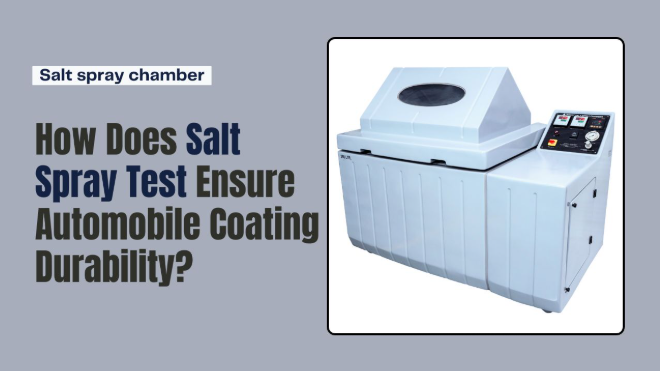In the extremely competitive automobile sector, automobile manufacturers and component makers need to make sure that each and every component of an automobile remains durable for ages—particularly as far as resistance to corrosion is concerned.
One of the more dependable and generally accepted means for assessing this is the salt spray test procedure. This method of accelerated corrosion testing allows predictions as to the relative performance of protective coatings, paint, and platings in their real-world uses. For car manufacturers, it is a prime test in their assurance of a vehicle coating’s long-term stability prior to entering the end-user market.
Understanding the Salt Spray Test Procedure
The salt spray test procedure, otherwise referred to as a salt fog test, is a laboratory-standardized test intended to evaluate coated metal surfaces for corrosion resistance. Usually performed as per international standards like ASTM B117 or ISO 9227, the test consists of subjecting samples to a fine spray of saltwater solution in an environment-controlled room.
This technique is applied at multiple stages of product development—right from R&D to quality checks—to ensure materials comply with tough performance standards. In the auto sector, salt spray testing is especially crucial to verify the effectiveness of protective coating on body panels, chassis components, fasteners, and undercarriage elements.
Why Coating Durability Matters in Automobiles
Vehicles run in varied environmental conditions—rain, snow, moisture, and road de-icers can all make unprotected metals corrode. Corrosion not only impairs appearance but can also weaken safety and structural support. It is therefore vital that each exposed or semi-exposed metal component in a vehicle be properly coated.
Through the reproduction of corrosive aggressive conditions in a shorter duration of time, the salt spray test process provides producers with information regarding the fate of their coatings during years of usage. By taking 240 to 1000 hours as a testing time, a 240-to-1000-hour test may duplicate months or years of weather exposure to tough conditions.
Key Steps in the Salt Spray Test Procedure
The salt spray test is performed on equipment specifically designed to provide even and repeatable test conditions such as the Testronix SST chamber. The basic steps are:
- Sample Preparation: The test specimens are coated, washed, and preconditioned according to the applicable standard.
- Placement in the Chamber: Samples are placed within the chamber at an angle that facilitates uniform exposure.
- Salt Mist Exposure: Atomized and sprayed within the chamber is a 5% sodium chloride solution, forming an even fog.
- Controlled Environment: Continuous circulating of salt fog is maintained by the chamber at a temperature of approximately 35°C.
- Evaluation: Following a specified test duration, samples are withdrawn and examined for evidence of corrosion in the form of rusting, blistering, or delamination of the coating.
By reproducing the salt spray test process under controlled conditions, engineers are able to compare various coating systems and optimize formulations for ultimate endurance.
Applications in Automotive Component Testing
A number of components in modern vehicles need corrosion testing, such as:
- Exterior panels and frames: These are most exposed to the environment and need to withstand environmental wear.
- Fasteners and brackets: Zinc-plated bolts and brackets are common candidates for testing.
- Suspension and steering components: Components near the underside of the vehicle are most prone to rust.
- Exhaust systems and engine parts: Despite thermal exposure, corrosion may still be a problem in high-humidity environments.
Automakers apply the salt spray test procedure to verify that these components satisfy internal requirements and regulatory standards before releasing vehicles into the market.
Role of the Testronix SST Chamber in Automotive Corrosion Testing
Salt spray testing with precision and accuracy demands reliable, precision-engineered equipment. Testronix SST chambers provide advanced features like digital temperature control, even fog distribution, and corrosion-resistant interiors. These enable repeatable results and minimize test variability—a critical requirement in high-volume automotive manufacturing.
Manufacturers benefit from the chamber’s ergonomic design and global test standard compliance, and it is perfect for use in automotive R&D and QA labs. It is possible for the teams to conduct long-duration tests with the Testronix SST chamber without worrying about equipment degradation and inconsistency in tests.
Conclusion
The procedure of the salt spray test is a crucial one within the automotive field in its role to ensure that vehicle coatings are up to the standards necessary for durable, long-term performance and safety. It avoids expensive product recalls and enhances customer confidence in the brand. Through the process of subjecting coatings to years of wear in a controlled setting, this test enables manufacturers to select and create the most durable of coatings.
For the very best in reliable and precise corrosion test equipment, Testronix delivers top-of-the-line solutions such as the Testronix SST chamber that can keep up with the strict requirements of the automotive industry. With heavy-duty construction, accurate controls, and international standard qualification, Testronix remains a quality assurance partner of choice for the automotive industry.

